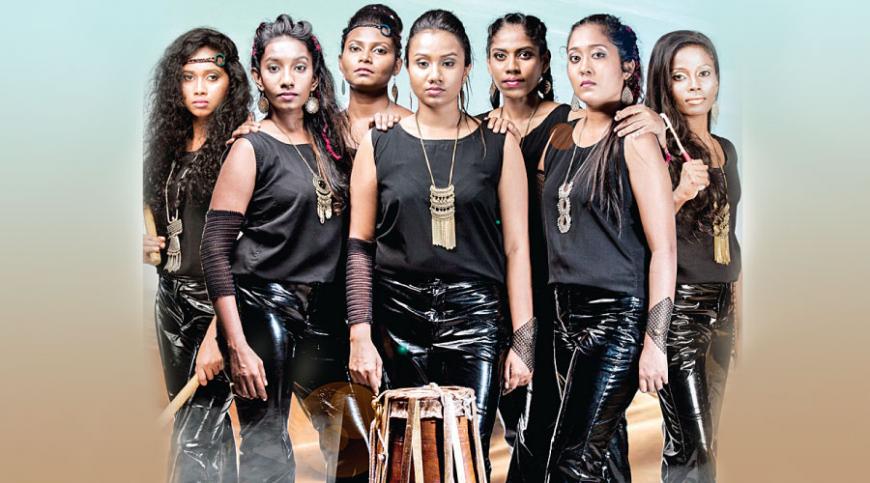
When they took to the stage alongside Stigmata- a heavy-metal band- at Rockfest last month, it was a rhythmic explosion. The sound of traditional drumming against the electric guitars and beating of western drums was near perfection - everyone went haywire.
What made that performance even more captivating is the fact that ‘they’ refer to Sri Lanka’s first-ever all-female drum percussion ensemble - Thuryaa. Thuryaa comprises women who are making history in a male dominant art form and are doing a mighty good job of it.
The art of traditional drumming stems back to when Arahat Mahinda arrived in Sri Lanka in 236 BCE. Since then, probably till 2015, the arena of drumming was ruled by men. Women were deliberately excluded from religious rituals or Shanthikarma, where drums were mainly used, because women were considered to be kili a term used to describe impurity.
“It was a discriminatory art-form. For a long time women were discouraged from learning traditional drumming,” said 29-year-old Sithara Maduwanthi, the founder and leader of Thuryaa, as she sat with Youth Observer to reflect on her journey.
The turning point of this narrative starts when Sithara walked into a tabla class at the University of the Visual and Performing Arts in Colombo where she earned her basic degree, and went on to become the first female percussion music graduate in the country.
“It is not easy to be a drummer. There are techniques to master, weight of the drums and the right amount of pressure you have to exert to make the perfect sound. It is not simply an art but a lifestyle,” Sithara explained.
Thuryaa is her brainchild, and this is how it came to life. One day a friend asked her to perform at a conference organised by the Leo Club. She went to her tabla lecturer - Shriyan Chandrasekara - and proposed a plan to assemble an all-female drum ensemble from scratch. Not an easy job. They had to call auditions. Twenty females were selected during the process. On the day of the first show - on February 10, 2015 there were only eight members remaining.
Today there are seven members in the main crew, Sithara, Chamini Dias, Shalini Yasodha, Chethani Ratnayake, Oshin Wijeratne, Maheshika Ekanayake, Upeshi Kanishka with Chandrasekara acting as its director.
“I know in my heart that there will not be other females in Sri Lanka with the hands the girls in Thuryaa have. They are the best in drumming,” Sithara declares.
Sithara has great gratitude to Naadro - an all-male percussion group because Naadro is responsible for the concept. “I have watched them perform. They are the best at what they do. My band was inspired by them,” she says.
Today on its third year, Thuryaa has bagged two top awards for music and art at the 18th Female Folk Dance Competition and Festival in Punjab, and performed in countries such as India, Taiwan, Singapore and Bangkok.
They have also evolved in their musical style to incorporate Western, Latin and other drumming techniques into theirs to present a real treat to listeners. What makes their work even entrancing is the fact that the girls ensure their music delivers a message. For example, ‘frame drums’ creates a depiction of the everyday life of a woman.
However, their journey till now was not a walk in the park. For their first show the ladies had to sing in trains to collect money to stitch costumes and buy necessary equipment. After a successful first show they did get invited to perform at shows that paid around Rs.20,000. All this money was deposited in an account and used to buy more equipment. They did not take any payment home, their families supported them.
“We won’t be where we are now if not for our families,” Sithara told the Youth Observer, “We also will not have come this far if not for the girls in the band. Our success is balanced in all our efforts.”
Joining the discussion Chandrasekara who has worked as a lecturer for the past eleven years says that he is proud of where Thuryaa stands now.
“It was a new experience for me too. All of this happened by chance and we have come a long way,” he says.
Thuryaa’s director also adds that in most parts of the world women and men both perform traditional music. They start as early as 4-5 years of age, but in Sri Lanka females start learning the art much later than men. Thuryaa is set to change this ideology.
“We are not here to challenge anyone. We just want everyone to enjoy a pure and authentic form of art,” he says.
Year 2020 is going to be a big year for the women because they will be celebrating five years together. Sithara has huge plans for the year too. One is to take their music to all interested because the beating of the heartbeat that is synonymous with the beating of the drum is common to all and that is reflected in their theme 'Share the rhythm of humanity'.
